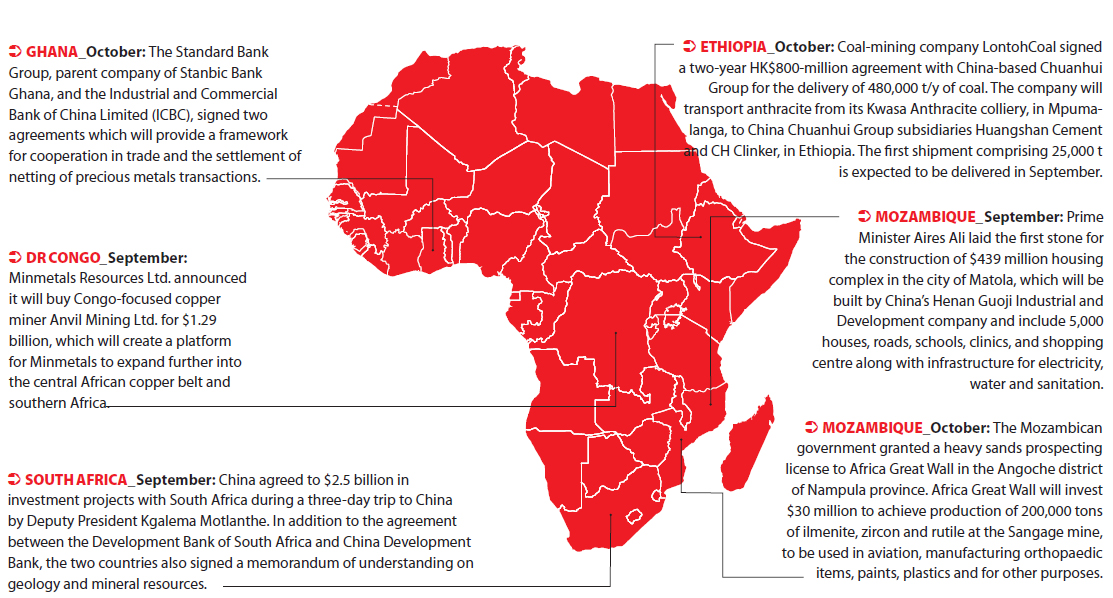|
Reaching Another Level in Sino-African Trade Relations
According to the latest projections from the African Development Bank (ADB), Africa's middle class will triple to more than 1 billion people in the next half-century as it predicts gross domestic product growth in the continent will exceed 5 percent a year over the same period. In recent years, Africa has been a somewhat overlooked source of stable growth amidst global economic turmoil which has brought growth in developed markets to a standstill. China's increased engagement with the continent is well documented, with trade between China and Africa exceeding $110 billion in 2010, a tenfold increase over the past decade. To accommodate the needs of Africa's growing middle class ranks, China will continue on the current path, with a few minor changes.
According to the ADB, Chinese investment in African infrastructure has remained stable at about $5 billion a year. However, much of that is a result of direct engagement with national governments. China must engage with regional bodies, with investment projects that transcend national boundaries, so that the impact can be greater. Investing in regional projects will require China to work closer with African regional groupings such as the East African Community, the Southern African Development Community, and the Common Market for Eastern and Southern Africa.
With pressing infrastructural demands in landlocked African countries that need access to the nearest sea ports, including Uganda, South Sudan, Zambia and Malawi, establishing regional transport infrastructures will also significantly reduce the costs of Sino-African trade and improve Chinese exporters' accessibility to Africa's growing consumer markets.
Currently, global manufacturers looking to shift production to lower cost countries complain that African transport prices are too high. Chinese manufactures to establish manufacturing faculties in Africa itself, to directly serve the African market. Developing industry in Africa will help diversify its economy, commercialize its agricultural sector, and become less dependent on the price of commodities. By 2060, China is projected to receive 60 percent of African exports, up from 5 percent today.
To realize this projection, Africa's leaders will need to complement Chinese regional engagement by realizing a common vision and moving beyond free-trade agreements to real integration of licensing, border control and visas etc., in order to better engage with the Chinese government, EPC contractors and other Chinese entities. Rather than having a few select countries becoming relevant on the world stage, greater coordination between leaders and regions will help ensure Africa will become a global force. Only then can Africa and China fully take advantage of the opportunities presented in this new era of Sino-African relations.

➲ GHANA_October: The Standard Bank Group, parent company of Stanbic Bank Ghana, and the Industrial and Commercial Bank of China Limited (ICBC), signed two agreements which will provide a framework for cooperation in trade and the settlement of netting of precious metals transactions.
➲ DR CONGO_September: Minmetals Resources Ltd. announced it will buy Congo-focused copper miner Anvil Mining Ltd. for $1.29 billion, which will create a platform for Minmetals to expand further into the central African copper belt and southern Africa.
➲ SOUTH AFRICA_September: China agreed to $2.5 billion in investment projects with South Africa during a three-day trip to China by Deputy President Kgalema Motlanthe. In addition to the agreement between the Development Bank of South Africa and China Development Bank, the two countries also signed a memorandum of understanding on geology and mineral resources.
➲ ETHIOPIA_October: Coal-mining company LontohCoal signed a two-year HK$800-million agreement with China-based Chuanhui Group for the delivery of 480,000 t/y of coal. The company will transport anthracite from its Kwasa Anthracite colliery, in Mpuma- langa, to China Chuanhui Group subsidiaries Huangshan Cement and CH Clinker, in Ethiopia. The first shipment comprising 25,000 t is expected to be delivered in September.
➲ MOZAMBIQUE_September: Prime Minister Aires Ali laid the first stone for the construction of $439 million housing complex in the city of Matola, which will be built by China's Henan Guoji Industrial and Development company and include 5,000 houses, roads, schools, clinics, and shopping centre along with infrastructure for electricity, water and sanitation.
➲ MOZAMBIQUE_October: The Mozambican government granted a heavy sands prospecting license to Africa Great Wall in the Angoche district of Nampula province. Africa Great Wall will invest $30 million to achieve production of 200,000 tons of ilmenite, zircon and rutile at the Sangage mine, to be used in aviation, manufacturing orthopaedic items, paints, plastics and for other purposes.
The ChinAfrica Econometer is produced by The Beijing Axis, a cross-border business bridge to/from China in four principal areas: Commodities, Capital, Procurement, & Strategy.
For more information, please contact: Barry van Wyk, barryvanwyk@thebeijingaxis.com
www.thebeijingaxis.com
|